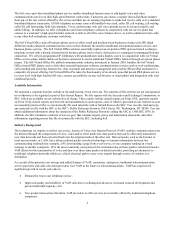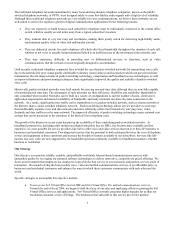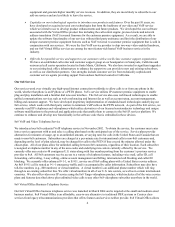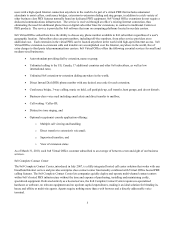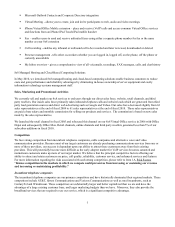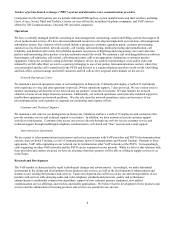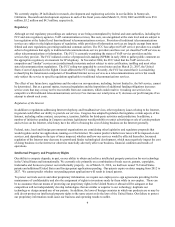8x8 2010 Annual Report Download - page 14
Download and view the complete annual report
Please find page 14 of the 2010 8x8 annual report below. You can navigate through the pages in the report by either clicking on the pages listed below, or by using the keyword search tool below to find specific information within the annual report.12
improve quality of service for real-time communications, managing effects such as packet jitter, packet loss, and unreliable
bandwidth, so that toll-quality service can be consistently provided. VoIP telephony equipment and services must achieve a
similar level of reliability that users of the PSTN have come to expect from their telephone service, and the cost and feature
benefits of VoIP must be sufficient to cause customers to switch away from traditional telephony service providers. We must
devote substantial resources to educate customers and end users about the benefits of VoIP telephony solutions, in general, and
our services in particular. Substantial, ongoing interaction with our customers in order to train and assist them with the
deployment and use of our services over these networks is sometimes required. If any or all of these factors fail to occur, our
business may be affected adversely.
We have a history of losses and are uncertain of our future profitability.
We recorded operating income of approximately $4 million for the fiscal year ended March 31, 2010 and ended the period with
an accumulated deficit of $199 million. In addition, we recorded an operating loss of approximately $3 million and $4 million
for the fiscal years ended March 31, 2009 and 2008, respectively. Although we achieved operating income of $4 million during
the current fiscal year, we may incur operating losses for the foreseeable future, and such losses may be substantial. We will
need to increase revenues in order to generate sustainable operating profit. Given our history of fluctuating revenues and
operating losses, we cannot be certain that we will be able to achieve operating profitability on an annual basis or maintain
operating profitability on a quarterly basis in the future.
Our business depends on continued and unimpeded access to the Internet by us and our users. Internet access providers
and Internet backbone providers may be able to block, degrade or charge for access to certain of our products and
services, which could lead to additional expenses and the loss of users.
Our products and services depend on the ability of our users to access the Internet, and certain of our products require
significant bandwidth to work effectively. Currently, this access is provided by companies that have significant and increasing
market power in the broadband and Internet access marketplace, including incumbent telephone companies, cable companies
and mobile communications companies. Some of these providers have stated that they may take measures that could degrade,
disrupt or increase the cost of user access to certain of our products by restricting or prohibiting the use of their infrastructure to
support or facilitate our offerings, or by charging increased fees to us or our users to provide our offerings, while others,
including some of the largest providers of broadband Internet access services, have committed to not engaging in such
behavior. The ability of the FCC to regulate broadband Internet access services has been called into question by a recent ruling
of the United States Court of Appeals for the D.C. Circuit. While interference with access to our products and services seems
unlikely, broadband Internet access provider interference has occurred, in very limited circumstances in the U.S., and could
result in a loss of existing users and increased costs, and could impair our ability to attract new users, thereby harming our
revenue and growth.
The VoIP telephony market is subject to rapid technological change, and we depend on new product and service
introductions in order to maintain and grow our business.
VoIP telephony is an emerging market that is characterized by rapid changes in customer requirements, frequent introductions
of new and enhanced products, and continuing and rapid technological advancement. To compete successfully in this emerging
market, we must continue to design, develop, manufacture, and sell new and enhanced VoIP telephony software products and
services that provide increasingly higher levels of performance and reliability at lower cost.
Decreasing telecommunications rates and increasing regulatory charges may diminish or eliminate our competitive
pricing advantage.
Decreasing telecommunications rates may diminish or eliminate the competitive pricing advantage of our services, while
increased regulation and the imposition of additional regulatory funding obligations at the federal, state and local level could
require us to either increase the retail price for our services, thus making us less competitive, or absorb such costs, thus
decreasing our profit margins. International and domestic telecommunications rates have decreased significantly over the last
few years in most of the markets in which we operate, and we anticipate these rates will continue to decline in all of the
markets in which we do business or expect to do business. Users who select our services to take advantage of the current
pricing differential between traditional telecommunications rates and our rates may switch to traditional telecommunications
carriers if such pricing differentials diminish or disappear, however, and we will be unable to use such pricing differentials to
attract new customers in the future. Continued rate decreases would require us to lower our rates to remain competitive and
would reduce or possibly eliminate any gross profit from our services. In addition, we may lose subscribers for our services.


